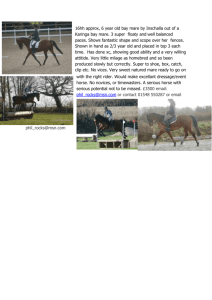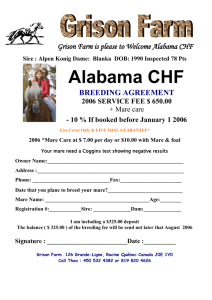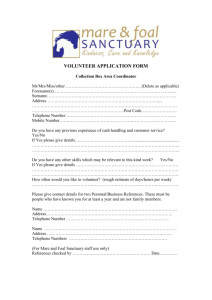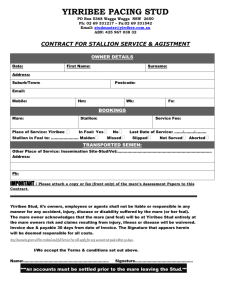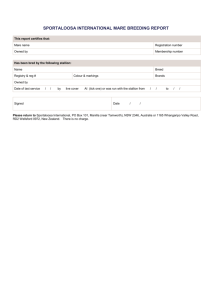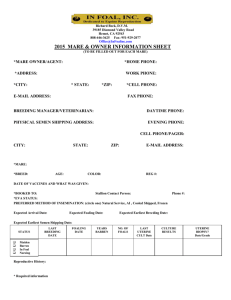Prepare a mare for serving and hold for service
advertisement
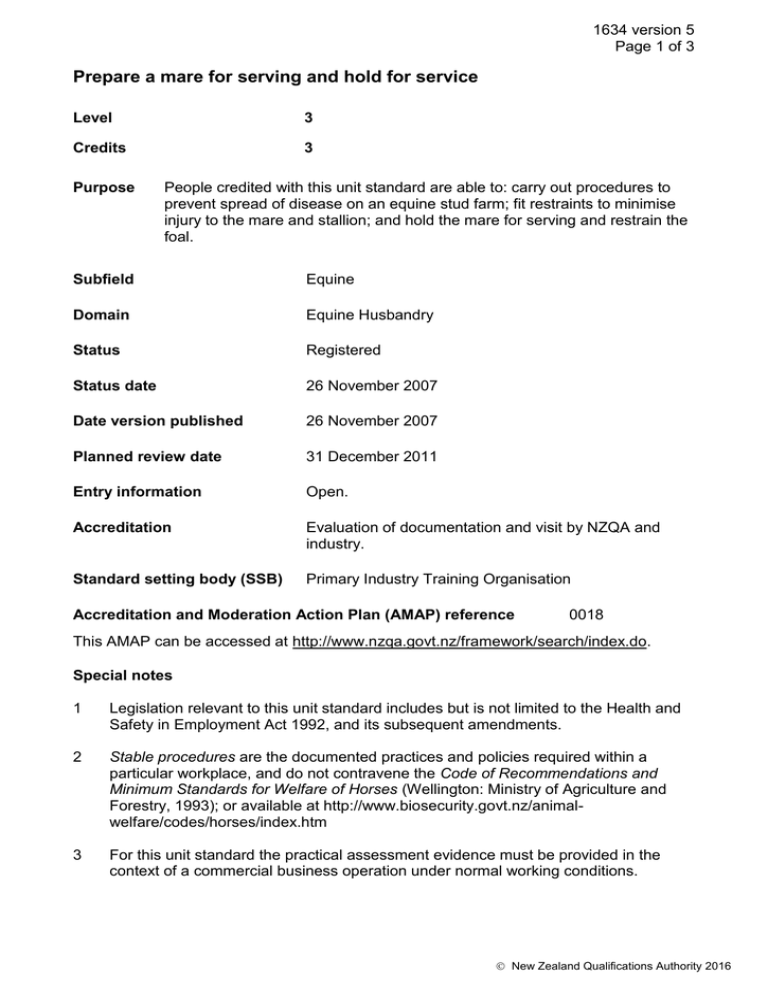
1634 version 5 Page 1 of 3 Prepare a mare for serving and hold for service Level 3 Credits 3 Purpose People credited with this unit standard are able to: carry out procedures to prevent spread of disease on an equine stud farm; fit restraints to minimise injury to the mare and stallion; and hold the mare for serving and restrain the foal. Subfield Equine Domain Equine Husbandry Status Registered Status date 26 November 2007 Date version published 26 November 2007 Planned review date 31 December 2011 Entry information Open. Accreditation Evaluation of documentation and visit by NZQA and industry. Standard setting body (SSB) Primary Industry Training Organisation Accreditation and Moderation Action Plan (AMAP) reference 0018 This AMAP can be accessed at http://www.nzqa.govt.nz/framework/search/index.do. Special notes 1 Legislation relevant to this unit standard includes but is not limited to the Health and Safety in Employment Act 1992, and its subsequent amendments. 2 Stable procedures are the documented practices and policies required within a particular workplace, and do not contravene the Code of Recommendations and Minimum Standards for Welfare of Horses (Wellington: Ministry of Agriculture and Forestry, 1993); or available at http://www.biosecurity.govt.nz/animalwelfare/codes/horses/index.htm 3 For this unit standard the practical assessment evidence must be provided in the context of a commercial business operation under normal working conditions. New Zealand Qualifications Authority 2016 1634 version 5 Page 2 of 3 Elements and performance criteria Element 1 Carry out procedures to prevent spread of disease on an equine stud farm. Performance criteria 1.1 Ways in which contamination can spread are outlined in terms of lack of hygiene, and contact of reproductive organs with bacteria of external environment. 1.2 The mare is cleaned to remove signs of faeces and dirt, according to stable procedures. Range 1.3 vulva, perineum, anus, hindquarters, under tail bone. Tail bandaged to two thirds length of tail bone is firm enough to prevent slipping during mating. Element 2 Fit restraints to minimise injury to the mare and stallion. Range may include but is not limited to - serving hobbles, hind leg boots, leg strap, twitch, neck protector. Performance criteria 2.1 Description of restraints identifies their purpose and action. 2.2 Leg restraints are fitted in a manner which is comfortable for the mare, firm enough to stay in place for serving and to fulfil stated function. 2.3 Twitch is applied firm enough to create quietening effect while maintaining circulation to twitched area. Element 3 Hold the mare for serving and restrain the foal. Performance criteria 3.1 Foal is restrained within sight and sound of the mare, allowing movement without causing damage to itself. 3.2 The lead rope and twitch are held while serving is carried out in a manner which restrains the mare and is safe for the mare, handler, and other personnel. 3.3 Restraints are removed as soon as possible after serving in a manner which is safe for the mare and handler. New Zealand Qualifications Authority 2016 1634 version 5 Page 3 of 3 Please note Providers must be accredited by NZQA, or an inter-institutional body with delegated authority for quality assurance, before they can report credits from assessment against unit standards or deliver courses of study leading to that assessment. Industry Training Organisations must be accredited by NZQA before they can register credits from assessment against unit standards. Accredited providers and Industry Training Organisations assessing against unit standards must engage with the moderation system that applies to those standards. Accreditation requirements and an outline of the moderation system that applies to this standard are outlined in the Accreditation and Moderation Action Plan (AMAP). The AMAP also includes useful information about special requirements for organisations wishing to develop education and training programmes, such as minimum qualifications for tutors and assessors, and special resource requirements. Comments on this unit standard Please contact the Primary Industry Training Organisation standards@primaryito.ac.nz if you wish to suggest changes to the content of this unit standard. New Zealand Qualifications Authority 2016
